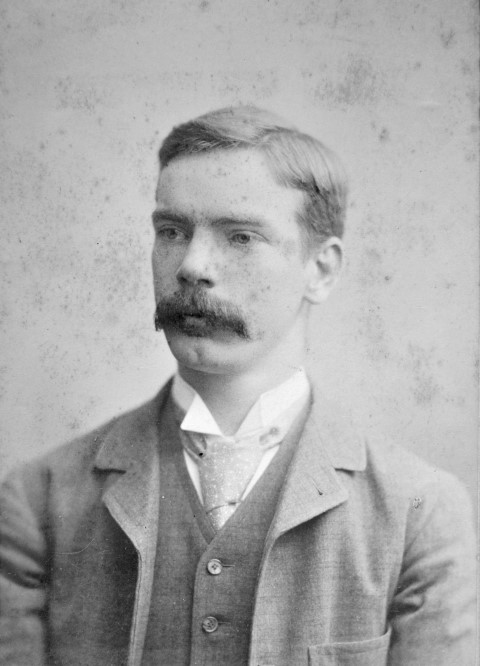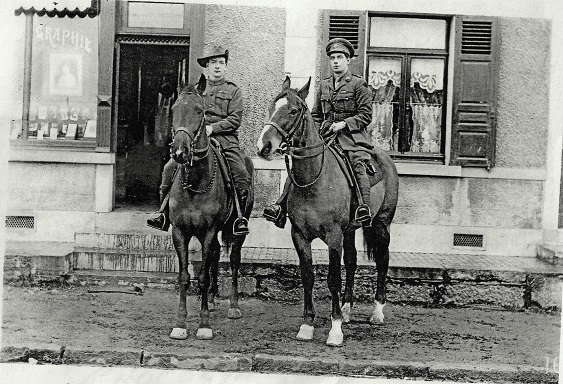

George Robertson, photograph taken in the late 1800's.
George was born on 7 May 1868, the eighth child of John Robertson, a Scottish migrant living in Geelong, Australia.
George received a certificate as a First Class Engine Driver on 14 July 1893 at the age of 25.

George's engine driver certificate.
George Robertson met Jessie Ethel Mary Neilson, the daughter of Henry Cumming Neilson (1840 - 1930) and they married on 9 November 1893 in Geelong. Their marriage certificate shows that they were married by Arthur Davidson at what appears to be the YMCA Building on Ryrie Street, Geelong, 'according to the rites of the Presbyterian Church'. George's address was given as Little Ryrie Street and his rank or profession was given as 'Pattern Maker'. Jessie's address was shown simply as 'St Arnaud'.
George kept a Cash Book in which he recorded all the details of his finances from May 1897. Much of the following story is derived from the information in that book.
George purchased a property at Little Ryrie Street on 1 May 1897 for £330, with a loan of £330 from his father John. He spent £50 on improvements. The cash book records the repayments he made to his father.
George and Jessie had the following children:

The child in the photograph above, taken in 1902, is believed to be the five year old Henry Cumming Robertson, as all the other children in the photograph can be accounted for.
In later life Marjorie Preston referred to the 'boy in the cupboard'. It is not clear who she was referring to, but it may have been her brother Henry, who was eight years older than her, and who may have been kept secluded from the public eye - no family photographs show Henry. See also below.
At the end of December 1903, George's house at Little Myers Street was valued at £350. He had liabilities of £1698.48, including a loan to 'JR' (likely his father John Robertson) of £280. His annual salary (from 'personal exertions' at John Robertson & Sons in 1904 was £306 and he received rent (from where it is not clear, but possibly from a boarder called P J Stevens) of £26.
George's father John Robertson died in September 1904. By December 1904, George's salary was £357, he again received rent of £26. He also received an initial amount of £30 from the estate of his father. Even though his father had died, George continued to pay off the loan for the house and by October 1906 it was paid off.
On 1 January 1906, after his father's death, George and his brother William Croll Robertson ('WCR' in the Cash Book) purchased in equal shares his father's Saw Mill and associated machinery for £2,800. By December 1907 the loan was reduced to £2300.
On 3 September 1906, George acquired a property at Victoria Parade for £500. The property appears to have been sold to Mr J Higgins in possibly late 1908 for £627.
George's salary increased again and in December 1906 he received £560. P J Stevens paid rent of £19 (and was not present the following year).
Sometime after October 1906, George acquired land and built a house at 41 Aphrasia Street, Newtown, which was large enough to have boarders paying rent. The Cash Book records that the land cost £231 and was acquired from G A Smart; the total cost of building was £1,043.14.2. This included the acquisition of blackwood from John Roberton and Sons.
On 1 August 1909, George borrowed £700 from a Mrs Caddy 'through Mssrs Harwood and Pencott'. The purpose of the loan is not recorded.
On 11 October 1910 he borrowed £70 from his mother, which appears to have been repaid by September 1913.
On 14 May 1913, George's mother Isabella Burns Robertson died. Isabella had almost certainly inherited her husband John's estate as George's Cash Book shows the value of John's estate at the time of Isabella's death. This included loans to his children and others including John Robertson and Sons, totalling £3,946.4.10 (of which £2,300 was to the business). All up, John's assets were valued at £5,253,8.3. Isabella's own assets were valued at £857.17.7. The Cash Book notes that '£120.15.6 to go to Misses Jean, Christina and Jessie Croll Robertson in 3 equal shares. Leaving £634.14 to be divided into 16 parts and appportioned as per Will dated 25 August 1904'. Payments were made in four divisions to all seven children from December 1913 to July 1914. For an unknown reason, the oldest daughter Jean received higher amounts, the rest received equal amounts.
On 20 December 1913, George lent £328.11.5 to John Robertson and Sons, 'repaid on amalgamation' on 30 January 1914. He must have been feeling generous for, on 24 December 1913 he lent £25 to Edward Albert Port. Whether Edward fully paid the loan or not is not clear; a total of £15.50 is recorded as having been paid and then the words 'Cleared Out' appear at the end of the payments.
George's salary increased but then dropped to £470 (1913) and £400 (1914 and 1915). It was £325 in 1918 and 1919 and began to recover after that, back to £500 in 1921 through to 1929 (he was 61 at this point).

George and Jessie Robertson, Marjorie and Ewen, photograph taken around 1915.
Family photographs taken from around 1915 show neither older son John Charles Robertson, then 21, or Henry Cumming Robertson, who was then 18.
In 1915, Henry Cumming Robertson was committed to the Hospital for the Insane at Kew at the age of 18 years, 'on the warrant produced on 31 December 1915', suffering from 'Congenital Mental Deficiency without Epilepsy'. He was 'in good bodily health on admission but some months afterwards had an attack of typhoid fever' from which he recovered satisfactorily. See below from 1926 for further details.
On 8 February 1916, George's son John Charles Robertson left for World War 1 (click link to read his WW1 history). John was close friends with his first cousin William Gray Dixon Robertson who was also known as 'Robbie' and also 'Billy' (born in 1895). The two of them were photographed together on horses in France or Belgium during World War 1.

Cousins William Gray Dixon Robertson and John Charles Robertson, in France or Belgium during World War 1.
On 11 December 1918, George wrote a slightly cryptic note in his Cash Book as follows:
2 Houses, 1 allotment between, $ell $ingly furniture someday. Annuity £80 from land + mortgage bank £250 on deposit (undecipherable characters) H+P more being added £50 for kerb and slab slope for draining on face. Keep left thing day. Bright-71. Cleark. 600 given to PJ y20 ago when Hd Living. 1 to each Fam 1. 20 gift to JC. Deeds with L or B.
On 30 September 1925, George lent an unrecorded amount to Pettitt and Robertson 'for 5 years @ 5%'. This amount was 'completely paid up on squaring up.'

George and Jessie Robertson, Marjorie and Ewen, photograph believed to be taken in 1925.
Henry Cumming Robertson continued in his usual health until October 1926 when he became rapidly thinner and weaker'. He was removed to the Hospital Ward (also referred to as 'the Male Hospital' of 'the Idiot Asylum Kew' on 5 November 1926 'in a weak condition, was taking very little nourishment, and had an (running?) temperature'. He was treated by the Medical Officer but did not improve and became weaker. His condition 'became rapidly worse' and, despite being attended to, he died, at midday on 8 November 1926. The Schedule of Deaths states that the cause of death was 'Generalised Tuberculosis'. Henry may have been known as 'the boy in the cupboard' - see below.
Henry Cumming Roberston was buried at Geelong's Western cemetery. His parents would be buried alongside him later.
George ceased working for Pettitt Robertson in late 1929 but remained a shareholder with a substantial investment in the business. His Cash Book shows that he received '1/12' of £500, or £41 in 1930. He also received rent of £65 from Mrs Botterell and appeared to have some other sources of income. But at the same time he spent £93 on house repairs and also paid two sums of £21 to a Mrs Caddy from whom he borrowed money. He appears also to have borrowed money from a Mrs Jones.

George and Jessie with their grandchildren Jock, Cargill and Pam around 1930. It is not known who the other woman is.
For the financial year July 1930 - June 1931, George shows his income as 'Nil'; he also received a very small amount as 'unemployment tax'. He received rent of £130, interest of £110 and a further £40. From around this time George appears to have acquired chickens as a means of finding some income. For 1931/1932, his only income was shown as 'poultry - £50', broken down as: nett return from eggs £103 and from poultry £7 and sale of chicks £10; less cost of feed £70. He also received rent of £130. He repaid Mrs Caddy £35, and Mrs Jones £36 in interest on loans.
Pettitt Robertson ceased to exist by mid October 1932. George lost all his investment in the business - see the web page on the business for more details, including correspondence with George from the Receiver.
In June 1933, George showed that he earned £66 from the poultry business and received £113 in rent from 41 Aphrasia Street. The following year, he earned £155 from selling eggs, and £13 from poultry. Feed for the chickens cost £105. His Cash Book records that he had an average number of 320 chickens from 1932 to 1933.
By mid 1934, he recorded his assets as follows:
George continued to sell poultry and eggs from 1934 to 1936. In June 1936, the Cash Book records income of £46 as a 'Poultry Farmer' and a further £42 from salary (the occupation is difficult to read, it looks like 'Sailors Risk').
George died on 7 November 1936 in Geelong. Jessie died on 28 August 1939, also in Geelong. They are buried together next to their son Henry Cumming Neilson in a large double plot with granite edges, in Geelong's Western cemetery.
Page created 11 February 2012, updated 23 December 2022 (update to burial details). Copyright © Andrew Warland. (andrewwarland(at)gmail.com)